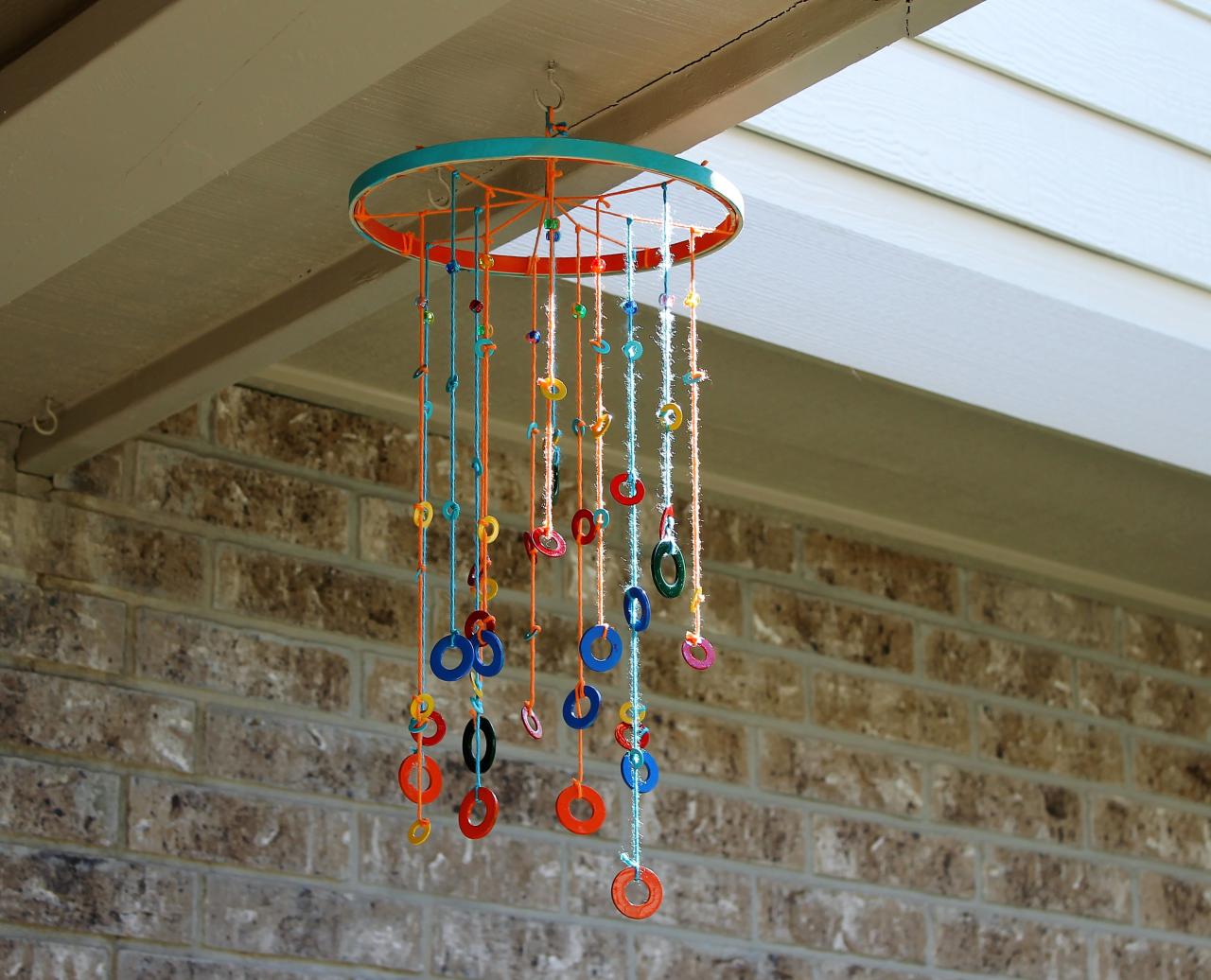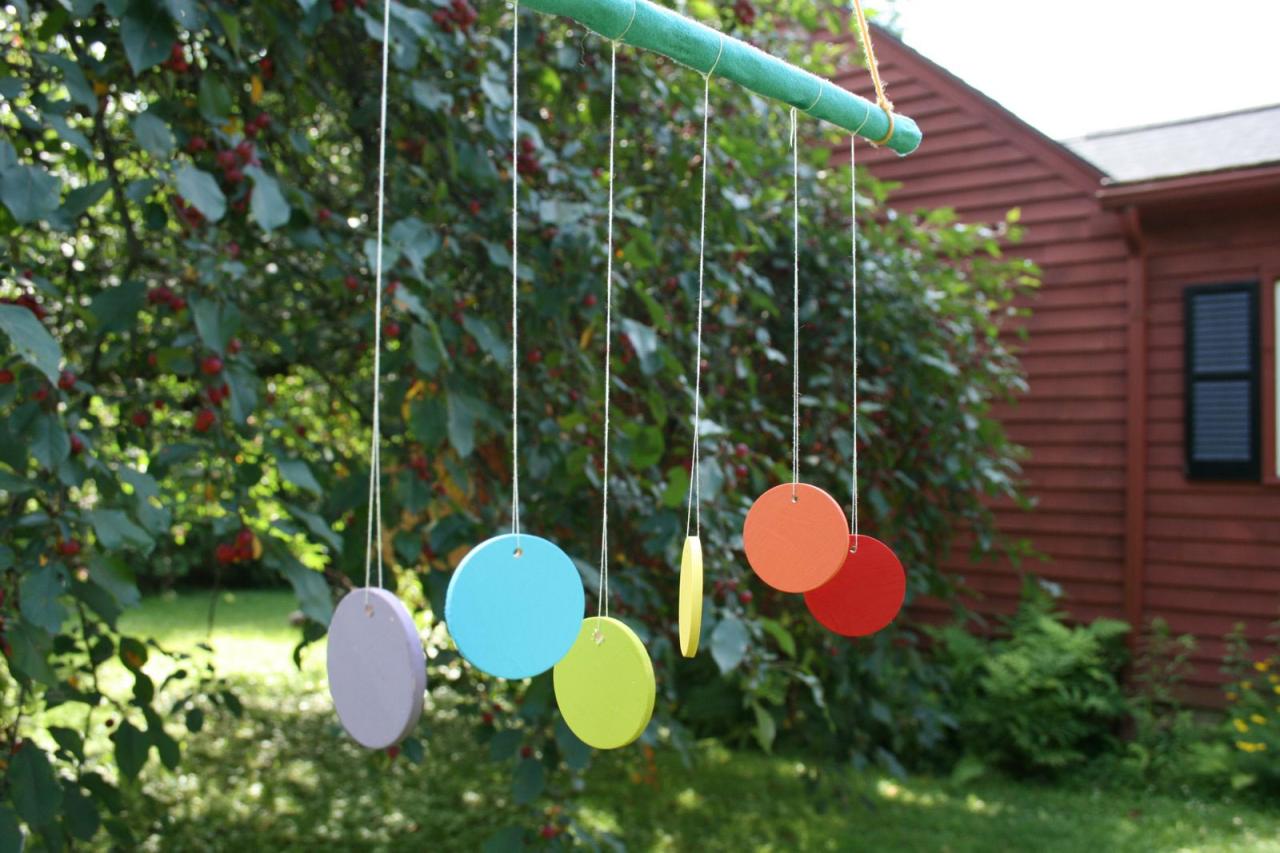DIY wind chimes offer a delightful way to add a touch of whimsy and sound to your outdoor space. These handcrafted creations not only provide a soothing ambiance but also serve as a testament to your creativity. From the gentle tinkling of glass beads to the resonant tones of metal tubes, wind chimes create a symphony of sounds that dance with the breeze.
Whether you’re drawn to the traditional elegance of a wooden frame adorned with metal tubes or the modern simplicity of a minimalist design featuring glass beads, there’s a DIY wind chime project waiting to be brought to life. The beauty of DIY wind chimes lies in their versatility – you can personalize them with your favorite materials, colors, and designs, reflecting your unique style and preferences.
Introduction to DIY Wind Chimes
Wind chimes, with their soothing melodies and captivating aesthetic, have a long and rich history, spanning cultures and centuries. They are more than just decorative elements; they symbolize peace, harmony, and connection to nature.
The enchanting sounds of wind chimes arise from the interplay of wind, design, and the principles of sound. As the wind flows through the chime, it causes the hanging elements, often called “clappers,” to strike against the chime’s tubes or plates. The frequency of these strikes determines the pitch, while the materials and shape of the chime influence the overall tone and resonance.
Choosing Materials and Tools
Selecting the right materials and tools is crucial for crafting wind chimes that are both aesthetically pleasing and sonically satisfying. Here’s a breakdown of essential considerations:
- Materials: A wide array of materials can be used for wind chimes, each offering unique sonic characteristics. Popular choices include:
- Metal: Aluminum, brass, copper, and steel produce bright, resonant sounds. Aluminum is lightweight and affordable, while brass and copper offer warmer tones. Steel provides a more robust and durable option.
- Wood: Wooden chimes create a mellow, earthy sound. Different types of wood, such as bamboo, cedar, and walnut, yield distinct tonal qualities.
- Glass: Glass chimes produce a clear, delicate sound. They come in various shapes and sizes, adding visual interest to your wind chime.
- Seashells: Seashells offer a natural and unique sound, often characterized by a gentle, calming effect.
- Other materials: Be creative and experiment with materials like stones, ceramic tiles, or even recycled items.
- Tools: The tools needed for your DIY wind chime project will depend on the materials you choose. Here are some common tools:
- Scissors or wire cutters: For cutting materials like string, wire, or metal.
- Drill: For creating holes in materials for hanging and stringing.
- Hammer: For securing elements and creating a more robust construction.
- Measuring tape: For accurate measurements and ensuring consistent spacing.
- Glue or adhesive: For attaching elements securely.
- Safety equipment: Always wear appropriate safety glasses and gloves, especially when working with sharp tools or materials.
- Choose materials that complement each other. The materials you choose should work well together in terms of color, texture, and weight. Consider using a variety of materials to create visual interest and a diverse sound.
- Use contrasting colors and textures. A combination of contrasting colors and textures can create a visually stimulating and dynamic wind chime. For example, you could use smooth, polished beads alongside rough, textured stones.
- Incorporate natural elements. Incorporating natural elements like shells, driftwood, or stones can add a touch of organic beauty to your wind chime. These materials also tend to create a more natural and calming sound.
- Consider the size and shape of your wind chime. The size and shape of your wind chime will affect its sound and appearance. A larger wind chime will produce a deeper, more resonant sound, while a smaller wind chime will produce a lighter, more tinkling sound.
- Hang your wind chime in a location where it will receive plenty of wind. The wind will activate the chimes and create the desired sound. Choose a location that is also visually appealing and allows the wind chime to be seen and heard.
- Always wear safety glasses to protect your eyes from flying debris.
- Use gloves when handling sharp objects like wire or metal rods.
- Ensure proper ventilation when working with paints, varnishes, or adhesives, as they can release harmful fumes.
- Keep tools sharp and in good working condition to prevent accidents.
- Store tools and materials safely when not in use to prevent injury.
- Choose a sturdy hanging point that can withstand the weight of your chimes and wind forces.
- Use weather-resistant materials for your hanging cord or wire, such as stainless steel or nylon.
- Apply a weather-resistant sealant to protect wooden or metal parts from moisture and UV damage.
- Ensure the chimes are hung in a location that allows for adequate air circulation to prevent mold and mildew growth.
- Inspect the chimes regularly for any loose or damaged parts, and tighten or replace them as needed.
- Clean the chimes with a soft cloth and mild soap solution to remove dust and debris.
- Reapply a weather-resistant sealant every few months, especially if the chimes are exposed to harsh weather conditions.
- Store the chimes indoors during extreme weather events, such as heavy storms or prolonged periods of freezing temperatures.
- For minor damage, you can often repair the chimes using glue, epoxy, or other suitable adhesives.
- For more significant damage, you may need to replace the affected parts.
- It’s always a good idea to keep spare parts on hand, such as hanging cords, beads, or metal tubes, for easy repairs.
- Ancient China: Wind chimes, known as “feng ling,” have a long and rich history in Chinese culture. They were often used in temples and palaces, symbolizing good luck, harmony, and the expulsion of evil spirits. The sounds of the chimes were believed to attract positive energy and ward off negative influences.
- Japan: In Japan, wind chimes, known as “fuurin,” are often made from bamboo and feature delicate, tinkling sounds. They are typically hung outside homes during the summer months, symbolizing the arrival of the cool breeze and the beauty of nature.
- Native American Cultures: Wind chimes played a significant role in Native American culture, often used in ceremonies and rituals. The sounds of the chimes were believed to communicate with spirits and invoke blessings. Different materials and designs were used to represent specific tribes and their traditions.
- Victorian Era: During the Victorian era, wind chimes gained popularity in Europe, particularly in England. They were often crafted from intricate metalwork, featuring delicate designs and ornate patterns. Victorian wind chimes were a symbol of elegance and sophistication, reflecting the aesthetic sensibilities of the time.
- Etsy: Etsy is a popular online marketplace that features a wide selection of wind chime patterns and DIY kits. You can find everything from simple designs to intricate, handcrafted pieces.
- Pinterest: Pinterest is a great source of visual inspiration for wind chime designs. You can browse through countless images of wind chimes from different cultures and time periods, as well as find DIY tutorials and tips.
- YouTube: YouTube offers a wealth of video tutorials on how to make wind chimes. From basic beginner-friendly projects to more advanced techniques, you can find step-by-step instructions to guide you through the process.
- Blogs and Websites: Many blogs and websites dedicated to crafting and DIY projects feature articles and tutorials on wind chime making. These resources often provide detailed instructions, materials lists, and creative design ideas.
- David Roy: David Roy is a renowned wind chime artist known for his intricate and handcrafted metal wind chimes. His pieces often feature unique designs and textures, creating a mesmerizing visual and auditory experience.
- Susan McCarthy: Susan McCarthy is a talented wind chime maker who specializes in creating wind chimes from natural materials such as bamboo, driftwood, and shells. Her pieces are known for their organic beauty and the soothing sounds they produce.
- The Wind Chime Gallery: The Wind Chime Gallery is a popular online retailer that features a wide selection of wind chimes from both established and emerging artists. They offer a curated collection of unique and handcrafted pieces, showcasing the diversity and artistry of the wind chime world.
- “The Complete Book of Wind Chimes” by Carol H. Peterson: This comprehensive guide covers the history, design, and construction of wind chimes, providing detailed instructions and inspiration for both beginners and experienced crafters.
- “Wind Chimes: A Guide to Design and Construction” by John Smith: This book delves into the technical aspects of wind chime design, exploring the science behind sound production and offering practical tips for creating harmonious and balanced chimes.
- “Wind Chime Magazine”: This online magazine features articles, tutorials, and interviews with wind chime artists and makers. It offers a platform for sharing knowledge, inspiration, and the latest trends in the world of wind chimes.
Design Ideas for DIY Wind Chimes

Creating a wind chime is a fun and rewarding project that allows you to express your creativity and personalize your outdoor space. There are endless possibilities when it comes to design, materials, and sounds. This section will explore various design ideas for DIY wind chimes, giving you inspiration to craft unique and beautiful wind chimes that will add a touch of charm to your surroundings.
Design Types and Examples
The design of your wind chime will greatly influence its appearance and sound. Here are some popular design types to consider:
| Design Type | Materials | Sound | Example Image Description |
|---|---|---|---|
| Traditional | Metal tubes, wood frame | Clear, resonant tones | A wind chime with a wooden frame and hanging metal tubes of varying lengths. The tubes are typically made of aluminum or brass and produce a clear, melodious sound when struck by the wind. |
| Modern | Glass beads, metal wire | Soft, tinkling sounds | A wind chime made of glass beads strung on metal wire, with a minimalist design. The beads are typically clear or frosted and produce a soft, tinkling sound when the wind blows through them. |
| Nature-inspired | Shells, driftwood, stones | Organic, earthy sounds | A wind chime made of natural elements, such as shells, driftwood, and stones, with a rustic aesthetic. The materials are often found on beaches or in forests and create a soothing, organic sound. |
| Personalized | Upcycled materials, personal touches | Unique, customized sounds | A wind chime made of recycled materials, such as bottle caps, buttons, or old jewelry, with a personal touch. This type of wind chime allows you to express your creativity and add a unique touch to your design. |
Importance of Balance and Symmetry
Balance and symmetry are crucial aspects of wind chime design. They contribute to both the visual appeal and the sound quality.
A well-balanced wind chime will hang evenly and produce a harmonious sound.
A symmetrical design ensures that the weight is distributed evenly, preventing the chime from tilting or swaying excessively. It also creates a sense of visual harmony, making the wind chime more pleasing to the eye.
Tips for Creating Visually Appealing and Functional Wind Chimes
Here are some tips to help you create visually appealing and functional wind chimes:
Safety and Maintenance
Creating DIY wind chimes is a fun and rewarding project, but it’s essential to prioritize safety and proper maintenance to ensure your chimes last for years to come.
Safety Tips for Handling Tools and Materials
Safety is paramount when working with tools and materials. Here are some important tips to keep in mind:
Importance of Proper Installation and Weatherproofing
Proper installation and weatherproofing are crucial for the longevity and safety of your wind chimes.
Maintaining Wind Chimes for Long-Term Use
Regular maintenance ensures your wind chimes remain beautiful and functional.
Repairing or Replacing Damaged Parts
Sometimes, parts of your wind chimes may become damaged.
Wind Chime Inspiration and Resources

The world of wind chimes offers a rich tapestry of sounds and designs, drawing inspiration from diverse cultures and historical periods. From the delicate chimes of ancient China to the intricate metalwork of Victorian England, wind chimes have captured the imagination and provided a soothing melody to generations. Exploring the history and artistry behind these wind instruments can ignite your own creativity and inspire unique designs for your DIY wind chimes.
Wind Chime History and Cultural Influences
Wind chimes have been a part of human culture for centuries, with their origins traced back to ancient civilizations. Each culture has imbued wind chimes with its own symbolism and significance.
Online Resources for Wind Chime Patterns and Tutorials, Diy wind chimes
The internet offers a vast array of resources for wind chime enthusiasts, providing access to patterns, tutorials, and inspiration.
Renowned Wind Chime Artists and Makers
The world of wind chimes has also produced talented artists and makers who have dedicated their skills to crafting unique and beautiful wind instruments.
Books and Articles on Wind Chime Design and Construction
For those seeking in-depth knowledge on wind chime design and construction, several books and articles offer valuable insights and practical guidance.
Closing Summary
With a little creativity and a dash of DIY spirit, you can transform everyday materials into enchanting wind chimes. Whether you choose to follow traditional designs or embark on a journey of personalized expression, the process of crafting your own wind chimes is both rewarding and enjoyable. So, gather your materials, unleash your inner artist, and let the wind carry your melodies to the world.
DIY wind chimes are a delightful way to add a touch of whimsy and sound to your outdoor space. Whether you’re using seashells, metal chimes, or even recycled materials, there are endless possibilities for creating a unique and personal wind chime.
If you want to incorporate a specific melody or sound into your creation, you can use a youtube video to mp3 converter to extract the audio from a favorite song. The resulting MP3 file can then be used to create a custom wind chime that plays your favorite tunes.




